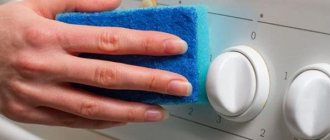In winter, the humidity level in the apartment drops to 15–20%. And that's bad. Why?
Firstly, because dehydrated air dries out the skin and mucous membranes, contributes to a decrease in immunity and the development of diseases such as sinusitis and sinusitis. By the way, young children are especially sensitive to its effects.
The second reason is that insufficient humidity harms plants, books, wooden furniture and musical instruments.
The optimal humidity level in an apartment is about 40–60%.
You can measure air humidity using a special device - a hygrometer. If you don't have one, use the following method. Fill a glass with cold water and leave it in the refrigerator until the temperature of the liquid drops to 3–5 °C. Then take out the glass and place it in a room away from the radiators. Observe the glass surface for five minutes. Evaluate the result this way:
- If the walls of the glass first fog up and then dry out after five minutes, the air in the room is dry.
- If after five minutes the glass remains foggy, the humidity is average.
- If streams of water appear on the glass, the humidity is increased.
Is the air dry? Then use one of the following techniques to restore normal humidity levels.
Dry things in the room
Another way that doesn’t require any effort on your part. Just place the dryer with washed clothes next to the radiator: the clothes will dry faster and the air will be saturated with moisture.
The main thing is that there are no cleaning products left on things. Otherwise you will breathe chemicals.
A similar way to humidify the air is to hang wet towels on the radiator. You can increase the lifespan of such a humidifier using a water bottle.
freee.ru
How to build such a structure is described in detail here.
Effective Hydration Methods
Humidifying the air in the apartment has a beneficial effect on well-being. If there is insufficient moisture, the inhabitants of the apartment will feel discomfort, expressed by drowsiness, lethargy and a feeling of dry eyes. Due to the low moisture content in the air, the skin dries faster, the mucous membrane of the nasopharynx dries out, which leads to a runny nose and further, along the chain, to more serious diseases.
Dry air is one of the causes of respiratory diseases
To avoid such consequences, it is necessary to maintain an appropriate indoor microclimate. Along with summer, special attention should be paid to humidity in winter, when the heating is turned on and, to retain heat, leaky windows are sealed, which only aggravates the situation.
Humidification through ventilation
How to humidify the air in an apartment without a humidifier? Let's consider several options for maintaining humidity. The most common is ventilation. We shouldn’t forget about this. Make it a habit. The room must be ventilated at least three times a day, regardless of the weather outside. It is enough to open the window for 10-15 minutes.
Regular ventilation will lead to a number of positive factors:
- freeing the room from unnecessary odors;
- reducing the amount of harmful impurities in the air;
- reducing the risk of mold;
- reduction of carbon dioxide in the environment;
- increasing oxygen in the room;
- normalization of moisture.
A crowd of people in a room, in the absence of ventilation, increases the carbon dioxide content by 20% above normal. This fact has a detrimental effect on health. Headaches may occur and fatigue may increase.
Ventilation not only cleans the air, but also normalizes its humidity
Ventilating rooms is most effective in winter, when it is fresh and frosty outside. In the summer, this is not so effective, when it is hot and much drier. In summer, it is recommended to use ventilation in the morning and evening after the temperature drops.
Water containers will increase moisture
Another common way to increase air humidity is to place containers of water in living rooms. In winter, water should be placed near the battery, above or below it. The liquid gradually evaporates and helps increase the air humidity in the apartment.
Humidification with a container of water
At the same time, it is necessary to periodically check the containers for the presence of water and replenish them on time, as well as monitor the cleanliness of the dishes to avoid problems with bacteria.
Help from indoor plants
An equally effective way to solve the problem of dry air is indoor plants that decorate the interior and humidify the air. Flowers can be used at any time of the year. To get the effect, they need to be watered regularly, with more frequent watering in the summer. For example, excellent moisturizers will be such specimens as Cyperus, Ficus, Dracaena, Monstera, Schefflera.
Dracaena is an excellent option for a home “humidifier”
A couple of flower pots are enough to humidify a room of 15-20 square meters. In addition to humidification, indoor plants purify indoor air.
Evaporation from wet fabrics
The next, but less aesthetic, method is using wet things. It is enough to hang washed clothes or towels on the radiator or dryer. When drying, moisture evaporates into the air, humidifying it.
2 in 1: Dry things and humidify the air
The disadvantage of this method is the short period of its action - things on a hot radiator dry out in just a couple of hours.
Spray bottle - a quick assistant
You can also increase the moisture content in the apartment using a regular spray bottle. To do this, you need to pour water into the container of this household assistant and walk through all the dry rooms, spraying water into them. This will instantly increase the humidity level.
Wet cleaning is the oldest method
A method such as wet cleaning is no less effective. To implement this task, you need to devote a little more time and physical activity. Wet cleaning must be carried out regularly.
Wet cleaning regularly to increase moisture in the air
After cleaning, it becomes fresher and easier to breathe. This is also a method of fighting infections, especially during epidemics of influenza and ARVI.
Homemade device
If time and skillful hands allow you to be creative, then you can design a humidifier for the battery with your own hands. To do this, you will need a piece of gauze 1 meter long, or a gauze bandage in the amount of 3 pieces, tape, fabric and a 1.5 liter plastic bottle.
- In an empty container, from a bottle, you need to cut a small rectangular hole. Its size is 10-12 cm in length and 5-7 cm in width. It should be located on the side of the homemade device.
- Next, you need to take any fabric and cut two ribbons of the same size. Hang the bottle using cut ribbons on the battery pipe with the hole at the top, next to the heating radiator. Secure the ribbons with tape.
- Make a strip 1 meter long and 10 cm wide from a piece of gauze, folding it several times. Unwind the gauze bandages and connect all the rolls to approximately the same size.
- The middle of the resulting gauze tape needs to be lowered into the cut hole, and the ends should be wound around the battery pipe in a spiral.
- You need to pour water into a plastic container.
- The homemade battery-powered humidifier is ready and can be used.
The easiest homemade humidifier is from a bottle
Aquarium or fountain
There is another, more expensive way to increase the humidity in an apartment - purchasing an aquarium or decorative fountain. This option will serve as entertainment for children, as interior decoration, and as a humidifier for the room.
The disadvantage of an aquarium is that it requires constant care and a specific place is allocated for its placement.
The fountain, on the contrary, is more compact in size. Performed in the form of all kinds of sculptures and compositions. Powered by electricity, which circulates water inside the fountain.
Home fountain - an attractive solution for hydration
If you place it next to plants, you can increase the moisture content in the apartment due to their interaction. When sprayed, water from the fountain falls on the leaves of the plants, and they, in turn, absorb water and release additional oxygen. The air will become more humidified and saturated.
Increased or decreased humidity levels affect not only people, but also interior items, furniture and household appliances. Therefore, it is necessary to maintain the required level of humidity in order to avoid problems with deterioration of comfort.
Boil
All you need is a stove and a saucepan or kettle.
- Option 1. Bring water in a saucepan to a boil and place it on a table or windowsill so that the steam humidifies the apartment.
- Option 2: Boil the kettle and leave it on low heat for longer evaporation. This technique can be used when you are preparing food (the air often becomes dry at this time).
You can also add a few drops of tea tree or eucalyptus oil to the water. Their aroma is soothing, and the vapors kill germs and reduce the risk of colds and flu. In addition, you can throw cinnamon sticks, herbs or other spices into the water to make the air fragrant.
Microclimate for children
Particular attention should be paid to the problem of dry air in rooms where children are. A child’s body is less developed, his immunity is lower, so he is more susceptible to various diseases. There is a misconception among parents that the children's room should be warm. They close all possible air supply units, turn on additional heating sources, do not ventilate the room, thereby reducing the humidity in the room and increasing the temperature to harmful values. This leads to diseases, because the child will not be able to adapt to normal air temperatures.
According to the norm, the optimal temperature in a children's room is 18-19°C, and the relative humidity is 50-70%.
To prevent diseases, it is necessary to maintain the proper level of humidity and temperature in the children's room.
There are acceptable standards for air temperature and relative humidity in rooms.
Table of temperature and humidity norms in various rooms
Place containers of water around the apartment
You can do without boiling. Simply fill vases, bottles and other containers with water and place them near heat sources. If you add stones and flowers, you will get a beautiful composition - guests, most likely, will not even realize that these are not decorative elements, but homemade humidifiers. Just remember to periodically wash the containers and change the water.
1 / 0
furnitureteams.com
2 / 0
domo.plius.lt
3 / 0
mynohar.com
How to measure humidity
You can measure the moisture content in the microclimate of your home using a special device - a hygrometer. If you don’t have it, you can use improvised means, for example: take an ordinary glass container (for example, a glass), fill it halfway with water and place it in refrigeration equipment for a while. When the water has cooled to 3-5 °C, place the tank away from the battery. After 5-10 minutes, one of three possible results will be visible:
- If there is no condensation (drops of water) on the walls of the vessel, the air is dry.
- If there are drops of moisture on the walls of the glass and they flow down it, the humidity is increased.
- If the walls are not dry and liquid does not flow through them, then the water content is within the burrow.
A simple way to determine the level of moisture in the air
Pay attention to the windows; if there is a high level of moisture in the house, they will fog up. Increased vapor content in the air negatively affects the condition of residents and their performance.
Why is dry air harmful to humans?
Muconasal secretion, secreted by the mucous membranes of the nasal cavity, acts as a barrier to the penetration of viruses and bacteria dangerous to humans into the body.
With a lack of humidity in the air, the mucous membranes dry out, and a lack of secretion occurs, which contributes to infection with influenza and other infectious diseases. A runny nose, sneezing, and coughing appear. Due to dryness and tension, microcracks form on the mucous membranes, which can become foci of purulent infections.
Dry air negatively affects the mucous membranes, the internal nasal cavity suffers, lips crack, general malaise occurs, and the risk of ARVI increases.
Being in a room with low humidity causes tears to dry out quickly. The surface of the eyes is not cleaned or moistened properly. Itching and redness appear. People who work at a computer or wear contact lenses are most affected.
Dry air affects not only the mucous membranes, but also the skin. Dry skin is more prone to allergic reactions and dermatoses. General well-being also worsens, a person gets tired faster and perceives information worse.
Young children are most sensitive to dry air. Doctors recommend maintaining relative humidity in the nursery at a level of at least 45-50%.
No. 9. More indoor plants
Everything is simple here. Plants need to be constantly watered, and some of them themselves provide good air humidification. These are ficus, hibiscus, dracaena, fatsia, nephrolepis or house fern, parmania or indoor linden, tradescantia, chlorophytum. You can place several small plants on the windowsill or a whole palm tree in the corner of the room. Both beautiful and practical.
Why is the air dry and humid?
A person breathes air that contains water vapor. The actual amount of this vapor in one cubic meter of air is called absolute humidity. Abbreviated: ABB. For example, if one cubic meter of air contains 15 g of water, then the absolute humidity is 15 g/m3.
The amount of water in the air varies, but there is a maximum possible saturation of air with water vapor at a given temperature. This value is called maximum absolute humidity, saturation limit or moisture capacity.
The lowest relative humidity on the planet is recorded in the Atacama Desert, on the Pacific coast of South America. Here it sometimes reaches a record 0%
The moisture capacity of air depends on its temperature: the higher the temperature, the more water the air can hold. As the temperature drops, it passes the dew point and the air can no longer hold the same amount of water vapor.
“Excess” moisture condenses and falls out in the form of dew, frost or frost. As a result, the current absolute humidity decreases.
As the temperature rises, the reverse process occurs—an increase in moisture capacity. In the presence of sources of water or steam, humidity will increase to the saturation limit characteristic of a given temperature.
Why is it necessary to humidify the air?
There are many ways to make your life more comfortable during the cold season, such as controlling the humidity in your home. Our environment has a strong influence on our physical and emotional well-being. An optimal indoor microclimate protects the body from infections and prevents apathy, which often occurs in winter. To maintain good health, good mood and productivity during the long winter months, it is necessary to control the temperature and humidity levels in the room. But then the question arises: how to humidify the indoor air at home?
The most obvious way to balance the temperature and humidity in a room is to open a window. However, this option is not suitable for winter, since drafts and cold air increase the risk of catching a cold. And the temperature in the room will drop too quickly, which, of course, will not contribute to the comfort of the residents. Therefore, it is important to know how to quickly humidify the air in a room without causing harm to it.
Using a hygrometer
Anyone who is concerned about the problem of air humidity in the apartment is recommended to purchase a hygrometer. This is a special device for obtaining the most accurate data, which can be used at home without any problems. Some models allow you to simultaneously determine not only the air humidity in the room, but also temperature and pressure.
Such devices can be:
- electronic;
- condensation;
- film;
- psychometric;
- by weight;
- hairy.
For use at home, the most optimal model is an electronic hygrometer. It is easy to use, has a compact size and attractive appearance, and is characterized by a relatively low cost.
No. 10. Aqua soil
These are colored balls that are actively used in gardening. They can quickly absorb water and then evaporate it. That's what we need. It is worth pouring the aqua soil into containers and placing it around the apartment. Since the balls are colored, they will not only moisturize, but also decorate the room. They need to be watered once and then stirred occasionally so that all layers of the substance release moisture back. Sometimes it is worth adding water.
How to make a humidifier with your own hands at home
Having considered the usual ways to humidify the air in a room without a humidifier, you should move on to simple devices made from scrap materials.
There are ceramic containers for air humidification that are mounted on heating radiators.
The simplest option is a humidifier made from a regular plastic bottle.
- Option 1. Materials: gauze bandage, two small wires, a bottle of mineral water or lemonade. You need to make a side cut ten centimeters long on the bottle. You need to secure the bottle with wire to the pipe leading to the radiator. Water is poured into the container. One end of the gauze strip is lowered into the liquid, and the other is wrapped around the pipe. To operate the device, you must remember to add liquid.
- Option 2. Materials – small fan, large bottle. The top of the container is cut so that a fan can be fixed into it. At a height of about ten centimeters, holes need to be made around the perimeter for air to escape. Water is poured so that it does not reach the ventilation slots by a few centimeters. The fan is inserted into the neck of the bottle and turned on.
Another device created from computer coolers and CDs:
Another simple, but surprisingly efficient design can be made using ordinary sponges for wet cleaning. The device will require a plastic container with a lid with a volume of 6-8 liters, about fifteen square flat sponges for wet cleaning and a computer cooler. The jaws are threaded through two guides. They can be simple wooden kebab sticks or solid pieces of wire. Such a “garland” is fixed in the container in such a way that one of its edges drops almost to the very bottom. You need to make three slits in the lid of the container. Two on the sides for air circulation and one in the center to secure the cooler. How such a device works is clearly shown in the following video:









